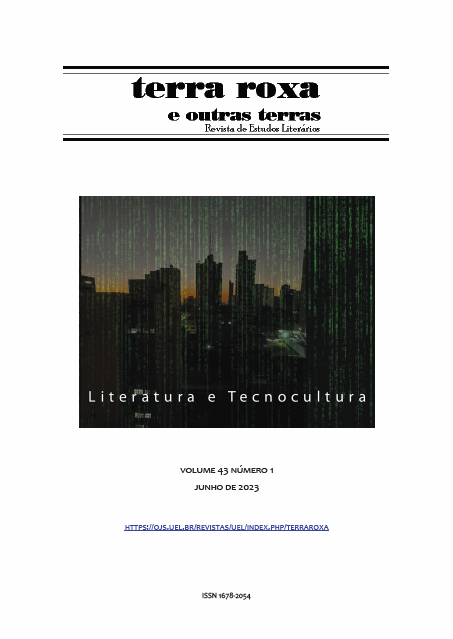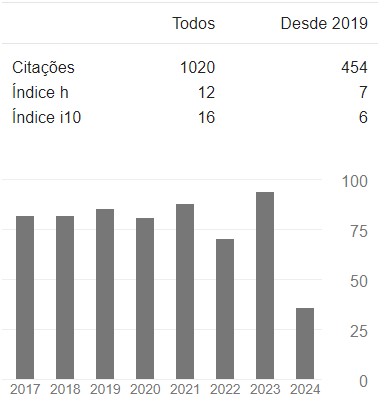Rhythm and meaning, by Hans Ulrich Gumbrecht
DOI:
https://doi.org/10.5433/1678-2054.2023vol43n1p117Keywords:
rhythm, meaning, functions of rhythmAbstract
Based on the idea that the association between rhythm and meaning has never been seen as a problem for literary criticism, this essay seeks not only to analyze the concept of rhythm but also to offer solid parameters for the investigation of the phenomenon in the analysis of its functions in the literary text. The author will use the ideas of Humberto Maturana and Francisco Varela as a basis, as well as the reflection of Paul Zumthor, who raised the line of academic reflection according to which the “dynamics of the voice” is an importante aspect for the phenomena associated to rhythm. Based on the analysis done in the essay, the idea is to problematize the association between rhythm and meaning, intiving critics, teachers and readers for a reflection about the phenomenon and outlining a line of investigation not well explored up this moment, and which consists in an element that constitutes, according to what the same author will call in another essay of his authorship, in the non-hermeneutic field and materialities of communication.
Downloads
References
BENVENISTE, Émile. La notion de “rythme” dans son expression linguistique. Problèmes de linguistique générale. Paris: Gallimard, 1966. 327-335.
HUSSERL, Edmund. Die Vorlesungen über das innere Zeitbewußtsein aus dem Jahre 1905. Edmund Husserl, ed. Zur Phänomenologie des inneren Zeithewußtseins (1893-1917). Den Haag: Nijhoff, 1966 [1905]. 3-98. DOI: https://doi.org/10.1007/978-94-015-3945-6_1
JAKOBSON, Roman. Linguistik und Poetik. Poetik: Augeswählte Aufsätze 1921-1971. Frankfurt am Main: Suhrkamp, 1979 [1960]. 83-121.
LUHMANN, Niklas. Das Kunstwerk und die Selbstreproduktion der Kunst. Hans Ulrich Gumbrecht & K. Ludwig Pfeiffer, eds. Stil: Geschichten und Funktionen eines kulturwissenschaftlichen Diskurselements. Frankfurt am Main: Suhrkamp, 1986. 620-672.
MATURANA, Humberto R. Biologie der Sprache: Die Epistemologie der Realität. Humberto R. Maturana. Erkennen: Die Organisation und Verkörperung von Wirklichkeit. Braunschweig: Vieweg, 1982. 236-271. DOI: https://doi.org/10.1007/978-3-322-91090-5_10
MATURANA, Humberto R. & Francisco J. Varela. Der Baum der Erkenntnis: Die biologischen Wurzeln des menschlichen Erkennens. Bern: Scherz, 1987.
MEAD, George Herbert. Die Philosophie der Sozialität. George Herbert Mead & Hansfried Kellner, eds. Philosofie der Sozialität: Aufsätze zur Erkenntnisanthropologie. Frankfurt am Main: Suhrkamp, 1969 [1929]. 229-271
SCHÜTZ, Alfred. Der sinnhafte Aufbau der sozialen Welt: Eine Einführung in die verstehende Sociozoligie. Vienna: Springer, 1960. DOI: https://doi.org/10.1007/978-3-7091-5948-4
ZUMTHOR, Paul. Introuction à la poésie orale. Paris: Seuil, 1983.
Downloads
Published
How to Cite
Issue
Section
License
Copyright (c) 2023 Greicy Pinto Bellin, Ana Paula Costa de Oliveira Padovino

This work is licensed under a Creative Commons Attribution 4.0 International License.
Authors who publish in this journal agree to the following terms:
a) The authors retain the copyright and grant the journal the right of first publication, the work being simultaneously licensed under the Creative Commons Attribution-NonCommercial 4.0 International License, allowing the sharing of the work with acknowledgment of the authorship of the work and initial publication in this journal.
b) Authors are authorized to assume additional contracts separately, for non-exclusive distribution of the version of the work published in this journal (eg, publish in an institutional repository or as a book chapter), with acknowledgment of authorship and initial publication in this journal.
c) Authors are allowed and encouraged to publish and distribute their work online (e.g. in institutional repositories or on their personal page) after the editorial process, as this can generate productive changes as well as increase impact and citation of the published work (See The Effect of Open Access).
d) The authors of the approved works authorize the journal to, after publication, transfer their content for reproduction in content indexers, virtual libraries and the like.
e) The authors assume that the texts submitted for publication are of their original creation, taking full responsibility for their content in case of any objection by third parties.



















